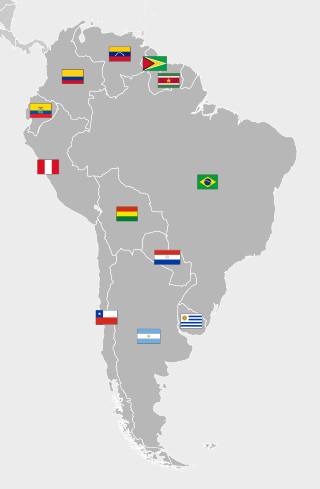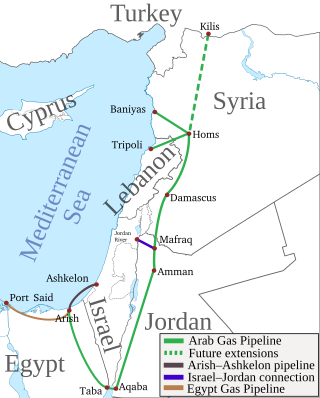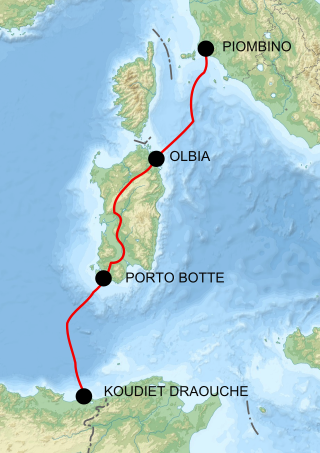
Transport infrastructure in Brazil is characterized by strong regional differences and lack of development of the national rail network. Brazil's fast-growing economy, and especially the growth in exports, will place increasing demands on the transport networks. However, sizeable new investments that are expected to address some of the issues are either planned or in progress. It is common to travel domestically by air because the price is low. Brazil has the second highest number of airports in the world, after the USA.

This is a gallery of flags of South American countries and affiliated international organizations.

Medgaz is a submarine natural gas pipeline between Algeria and Spain.

The Arab Gas Pipeline is a natural gas pipeline in the Middle East. It originates near Arish in the Sinai Peninsula and was built to export Egyptian natural gas to Jordan, Syria, and Lebanon, with branch underwater and overland pipelines to and from Israel. It has a total length of 1,200 kilometres (750 mi), constructed at a cost of US$1.2 billion.

GALSI was a planned natural gas pipeline from Algeria to Sardinia and further northern Italy, as an extension to the TransMed Pipeline.

The Trans-Mediterranean Pipeline is a natural gas pipeline from Algeria via Tunisia to Sicily and thence to mainland Italy. An extension of the TransMed pipeline delivers Algerian gas to Slovenia.

The Maghreb–Europe Gas Pipeline is a natural gas pipeline, which links the Hassi R'Mel gas field in Algeria through Morocco with Cordoba in Andalusia, Spain, where it is connected with the Spanish and Portuguese gas grids. Before the operation of the pipeline ceased in October 2021, it used to supply mainly Spain and Portugal, as well as Morocco with natural gas.

Brazil is the 7th largest energy consumer in the world and the largest in South America. At the same time, it is an important oil and gas producer in the region and the world's second largest ethanol fuel producer. The government agencies responsible for energy policy are the Ministry of Mines and Energy (MME), the National Council for Energy Policy (CNPE), the National Agency of Petroleum, Natural Gas and Biofuels (ANP) and the National Agency of Electricity (ANEEL). State-owned companies Petrobras and Eletrobras are the major players in Brazil's energy sector, as well as Latin America's.
The Southeast Northeast Interconnection Gas Pipeline (GASENE) is a 1,387 kilometres (862 mi) natural gas pipeline system in Brazil, which connects south-eastern gas system to the north-eastern gas system. It creates a common gas market in Brazil and allows gas import from Bahia. The project company of the GASENE system is Transportadora GASENE S.A., a subsidiary of Petrobras.
The Yabog pipeline is a natural gas pipeline. It is 441 kilometres (274 mi) long and connects Río Grande in Santa Cruz de la Sierra, Bolivia, with Campo Duran in Salta Province, Argentina. The pipeline was commissioned in 1972.
Cruz del Sur pipeline is a natural gas pipeline linking Buenos Aires in Argentina with Colonia del Sacramento and Montevideo in Uruguay.
Paraná-Uruguaiana pipeline is a natural gas pipeline from Aldea Brasilera, Paraná in Argentina to Uruguaiana in Brazil.
The Bolivia–Brazil pipeline (GASBOL) is the longest natural gas pipeline in South America. The 3,150 kilometres (1,960 mi) pipeline connects Bolivia's gas sources with the south-east regions of Brazil.
The Urucu–Manaus pipeline is a natural gas pipeline in Brazil. It allows use of the natural gas from Urucu, which is the largest onshore natural gas reserve in Brazil. The gas is used to substitute diesel and fuel oil for the electricity production in the state of Amazonas, and the pipeline supplies cities of Coari, Codajás, Anori, Anamã, Caapiranga, Manacapuru, Iranduba, and Manaus. The pipeline was inaugurated on 26 November 2009, and it is operated by Transportadora Urucu-Manaus S.A., a subsidiary of Petrobras.
The Statpipe pipeline is a natural gas system, which links northern North Sea gas fields with the Norway's gas export system. It transports gas from Statfjord, Gullfaks, Heimdal, Veslefrikk, Snorre, Brage and Tordis gas fields.
Gasoducto del Noreste Argentino is a proposed 1,465 kilometres (910 mi) long natural gas pipeline to transport natural gas from Bolivia to Argentina.

Mi Delirio World Tour is the first worldwide concert tour by Mexican singer Anahí, in support of her fifth studio album, Mi Delirio (2009). The tour was officially announced in August 2009 during her promotional tour in Brazil. According to Billboard, MDWT is the seventh most profitable tour of 2010.
The Arad–Szeged pipeline is a natural gas pipeline from Arad in Romania to Szeged in Hungary diversifying natural gas suppliers and delivery routes for the two countries and connects the two natural gas national grids. The pipeline attempts to lessen the two country's dependence on Russian energy. The Arad–Szeged pipeline is part of the larger New European Transmission System meant to unite Central and South Eastern Europe's natural gas transmission networks.
The BRUA pipeline is a natural gas pipeline from Podișor, Giurgiu County to Recaș, Timiș County part of the future Bulgaria, Romania, Hungary and Austria gas interconnector. The pipeline attempts to lessen the country's dependence on Russian energy and provide a new export route for the future natural gas exploitation in the Black Sea. The BRUA pipeline will be eventually linked to the Giurgiu–Ruse and the Arad–Szeged pipelines.
The following article presents a summary of the 2019 football (soccer) season in Brazil, which was the 118th season of competitive football in the country.








